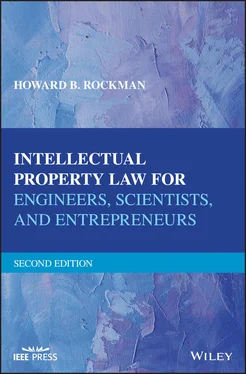It is important to note that patent applications that have not issued as patents are maintained in secrecy for 18 months after filing. After 18 months from filing of the earliest application, such as a provisional, for example, the patent application, as originally filed is published on the USPTO website. If the applicant does not want the application published, they must advise the USPTO that they will not be filing foreign patent applications directed to the same invention, and the application is not published. If the applicant changes its mind about filing corresponding foreign patent applications, the USPTO is so notified, and the patent application is published on the USPTO website shortly thereafter. When a patent does issue, any abandoned or previously identified patent application mentioned in the specification of that issued patent becomes available for public scrutiny.
9.6.3 Background of the Invention
9.6.3.1 Definition of the Field of the Invention
This portion of the specification comprises a very brief statement of the area of technology of the invention in general terms. Usually, a broad statement of the related art, followed by a specific statement identifying a particular branch or subdivision of the art to which the invention relates‚ is set forth. A statement as to the utility of the invention is usually also included.
9.6.3.2 Brief Description of the Problems That Exist in the Prior Art That the Invention is Directed Toward Solving
This portion of the patent application describes the problems which your invention is directed toward solving, followed by statements describing the content of a few closely related known prior art references that represent attempts by others to solve the same or similar problems in the past. The prior art is described, in brief terms, as what is disclosed in the reference patents or literature, followed by brief statements as to specific limitations or disadvantages of the prior art in terms of your invention, that is, what the prior art does not disclose. This indicates to the reader of the patent the specific problems in the related prior art that were not solved, and which your invention is directed toward solving.
The discussion of prior art in this portion of the application is in addition to any prior art statement (Information Disclosure Statement or IDS) that is submitted to the USPTO pursuant to Rule 56 (37 C.F.R. 1.56). The IDS lists prior art that the Patent Examiner is required to consider during examination, and should not be substituted for the portion of the patent application specification setting forth the content and shortcomings of specific prior art references. The language chosen in this portion of the patent application should emphasize the advantages of your invention over the prior art, and set forth the problems that remain unsolved by the prior art and which problems your invention solves.
9.6.3.3 The Results, Objectives‚ and Advantages of the Invention Not Achieved by the Prior Art
The next portion of the patent specification sets forth the results, advantages‚ and objectives sought to be obtained by your invention. At this stage of the application, these objectives, advantages‚ and results are stated without describing the structure or elements of the invention by which these results are obtained, or the function of the invention. As discussed in Chapter 10, the claims of the patent application are directed to defining the structure, steps‚ or elements of your invention, and the function of these elements; the portion of the specification referred to now sets forth the objectives, advantages‚ and results of using the elements, steps‚ and functions set forth in the claims. Conversely, the claims do not recite results. While the claims are intended to describe what the invention is, your statement of objects, advantages‚ and results is intended to describe what the invention accomplishes. These are statements of the broad aims to be achieved by the invention that are not achieved by the prior art.
The entire background portion of the specification is what I refer to as “the sales pitch” of the patent application. This is where you explain the differences between your invention’s objectives and the prior art, set forth the advantages of your invention over the prior art, and inform the reader of the problems your invention solves. This is the portion of the patent specification that will be referred to during the examination stage to convince the Patent Examiner that the only issue is the scope of the claims, not whether or not the application sets forth inventive subject matter. Well‐thought‐out statements of objectives and results help the examiner reach this intended result.
9.6.4 Brief Summary of the Important Elements of the Invention
This section of the patent application specification includes a brief summary of the invention, setting forth its elements and function, and immediately precedes the description of the drawings and the illustrated embodiments of the invention. The summary should set out the exact nature, operation‚ and purpose of the invention, and usually paraphrases the subject matter of the broadest claim. The summary of the invention is normally concise and reasonably general, and usually contains references to structure to enable the reader to understand the nature of the invention from the summary.
9.6.5 Brief Description of the Drawings That Illustrate the Invention
When drawings are submitted with the patent application, this portion of the specification sets forth a brief series of indented subparagraphs comprising descriptions for each figure shown. These subparagraphs are extremely brief, and specify information allowing the reader to determine what view of the invention they are looking at. The drawings are usually described in terms of perspective, plan, elevation, section, fragmentary, schematic, or exploded views. As stated before, in many chemical patent applications, no drawings are submitted with the application.
9.6.6 Detailed Description of the Illustrated Embodiment of the Invention
This is the longest section of the specification of the patent application, and comprises a detailed description of the invention’s structure and interrelated functions of the structural elements, followed normally by a description of one cycle of operation of the structure, where there is a cycle of operation. For example, compositions of matter do not have an operation to describe, except probably the method of making the composition. The description of the invention in this portion of the specification also describes the interrelationship between each of the elements of the invention, and their cooperation with each other. The description of the invention, as mentioned previously, must be set forth with such particularity to enable any person skilled in the art to make and use the claimed invention without undue experimentation once the patent expires. Since the extent of the knowledge of those skilled in the art varies from art to art, the level of detail varies from patent application to patent application. However, any doubt as to the amount of detail which should be included in the description of the invention should be resolved by adding detail. Remember that once the patent application is filed, no new matter can be added to the specification. Therefore, it is important to include all material elements and functions in the patent specification as initially written.
Normally, in describing a mechanical or electrical invention, the structure is defined in a logical way, usually from an input to an output, or from a base upward as in describing the construction of the invention. In the chemical field, detailed descriptions include a wide range of specific examples or embodiments of the invention, as well as all known equivalents of the specific elements of the invention. In non‐chemical cases, the detailed description need only cover one specific embodiment of the invention; however, it is preferable that alternative embodiments of the invention be set forth in the specification to advise the reader of the issued patent that several embodiments of the invention are covered by the issued patent’s claims.
Читать дальше












